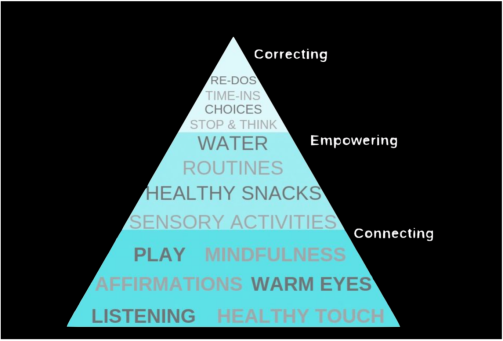“When you connect to the heart of a child, everything is possible.”
Dr. Karyn Purvis
What is TBRI?
Trust-Based Relational Intervention (TBRI) is an attachment-based, trauma-informed intervention that is designed to meet the complex needs of vulnerable children. The intervention is built upon three core foundations that include Empowering, Connecting, and Correcting Principles. TBRI uses Empowering Principles to address physical and environmental needs, Connecting Principles for attachment needs and engagement, and Correcting Principles to disarm fear-based behaviors.
While the intervention is based on years of attachment, sensory processing, and neuroscience research, the heartbeat of TBRI is connection.
The picture below demonstrates the reversal hierarchy of starting with connection opposed from correction. Traditional parenting models use an inverted pyramid that divides into thirds, with correcting occupying the largest segment, empowering the middle, and connecting the smallest. The TBRI model (pictured below) swaps the correcting and connecting slots, giving the latter a renewed focus. The TBRI model is really in the foundation of connection. How we connect with our children, our own personal histories, our own personal attachments, we’ve explored the mindfulness of adults to say where you are and where you’ve been matters how we parent our children.
So, when correction is necessary, the model address unacceptable behavior, but it does it in the context of connecting with our kids first and then empowering their bodies to be able to be regulated and connected to adults.

Who is TBRI for and who should use it?
TBRIis designed for children from “hard places” such as abuse, neglect, and/or trauma (which typically describes most foster and adopted children though this kind of trauma is not limited to foster/adoptive children). Because of their histories, it is often difficult for these children to trust the loving adults in their lives, which often results in difficult or big behaviors. TBRI offers practical tools for parents, caregivers, teachers, or anyone who works with children, to see the “whole child” in their care and help that child reach his or her highest potential.
Why use it?
Because of their histories, children from hard places have changes in their bodies, brains, behaviors, and belief systems. While a variety of parenting strategies may be successful in typical circumstances, children from hard places need caregiving that meets their unique needs and addresses the whole child.
Where do I start with TBRI?
Remembering the three principles of TBRI is key to bringing balance and perspective when you first begin. We all have a strength, a principle we are already very good at. Begin by recognizing your strength.
For example, you might know all there is to know about providing for your child’s brain and body in promoting health and support. You already have the best snack options, awesome routines that work for your family, the best Occupational Therapist, and all the right sensory toys/fidgets, so you are rocking the “Empowering Principles”. But the idea of sitting down and connecting with your twelve-year-old, and engaging in what they love to do, make you uncomfortable and you fear you do not know how to connect with them. You can’t imagine why you might need to learn Fortnight or all about The Avengers or things that make your child come to life? Therefore, understanding more about the Connecting Principles might be where you need to start. Hopefully, this quick overview of the three principles can equip you with a starting place to understanding and implementing TBRI into your household.
Next Steps/ How do I find out more information?
TBRI is a complex system to help us understand the multifaceted needs of our children. To learn more about TBRI and what it entails you can check out the Karyn Purvis Institute of Child Development’s website and YouTube channel. Read The Connected Child by Drs. Purvis and Cross, or attend a training through Apollos Center!
References:
Parris, S.R., Dozier, M., Purvis, K.B. et al. Implementing Trust-Based Relational Intervention® in a Charter School at a Residential Facility for At-Risk Youth. Contemp School Psychol 19, 157–164 (2015).
Purvis, K. B., Cross, D. R., Dansereau, D. F., & Parris, S. R. (2013). Trust-Based Relational Intervention (TBRI): A Systemic Approach to Complex Developmental Trauma. Child & youth services, 34(4), 360–386.
Nielsen, Lauren E., "Trust-Based Relational Intervention (TBRI) for Adopted Children Receiving Therapy in an Outpatient Setting" (2014). Honors Projects. Paper 165.
Reid, Mark J.; Proctor, Angela M.; and Brooks, Thomas R. (2018) "The Early Promise of TBRI Implementation in Schools," School Leadership Review: Vol. 13 : Iss. 2 , Article 2.
Karyn B. Purvis, David R. Cross, and Jacquelyn S. Pennings, Trust Based Relational-Intervention: Interactive Principles for Adopted Children with Special Social-Emotional Needs, 3 Journal of Humanistic Counseling, Education, and Development, Vol. 48 (Spring 2009).



